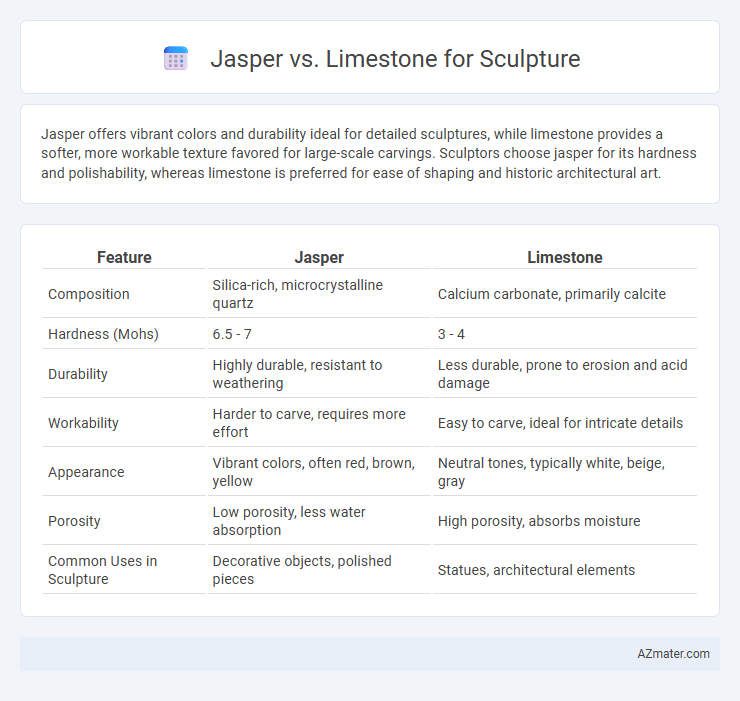Jasper offers vibrant colors and durability ideal for detailed sculptures, while limestone provides a softer, more workable texture favored for large-scale carvings. Sculptors choose jasper for its hardness and polishability, whereas limestone is preferred for ease of shaping and historic architectural art.
Table of Comparison
| Feature | Jasper | Limestone |
|---|---|---|
| Composition | Silica-rich, microcrystalline quartz | Calcium carbonate, primarily calcite |
| Hardness (Mohs) | 6.5 - 7 | 3 - 4 |
| Durability | Highly durable, resistant to weathering | Less durable, prone to erosion and acid damage |
| Workability | Harder to carve, requires more effort | Easy to carve, ideal for intricate details |
| Appearance | Vibrant colors, often red, brown, yellow | Neutral tones, typically white, beige, gray |
| Porosity | Low porosity, less water absorption | High porosity, absorbs moisture |
| Common Uses in Sculpture | Decorative objects, polished pieces | Statues, architectural elements |
Introduction: Jasper vs Limestone in Sculpture
Jasper and limestone are both popular materials for sculpture, each offering distinct characteristics that influence artistic expression and durability. Jasper, a dense and finely-grained variety of quartz, provides vibrant color variations and exceptional hardness, making it ideal for intricate details and polished finishes. Limestone, a sedimentary rock, is softer and easier to carve, favored for larger sculptures and classical forms due to its workability and natural, earthy tones.
Historical Significance of Jasper and Limestone
Jasper, prized since ancient times for its vibrant colors and hardness, has been used in sculpture to create enduring, intricately detailed works that symbolize protection and power in many cultures. Limestone, widely utilized by ancient Egyptians, Greeks, and Romans, features prominently in monumental sculptures due to its relative softness and abundance, facilitating large-scale artistic expression and architectural decoration. The historical significance of jasper lies in its gemstone status and ritualistic use, while limestone's importance is rooted in its practical versatility and widespread availability for classical and religious art.
Physical Properties: Jasper vs Limestone
Jasper is a dense, opaque variety of chalcedony with a hardness of 6.5-7 on the Mohs scale, making it highly durable and resistant to scratching, ideal for detailed and long-lasting sculptures. Limestone, primarily composed of calcium carbonate, is softer with a Mohs hardness of 3-4, making it easier to carve but more susceptible to weathering and erosion over time. The fine grain and consistent texture of limestone provide smooth sculpting surfaces, whereas jasper's rigidity requires specialized tools but results in a polished, vibrant finish.
Workability and Carving Techniques
Jasper, a dense and hard microcrystalline quartz, offers exceptional durability but requires advanced tools and patience when carving due to its toughness and brittleness. Limestone, composed primarily of calcite, is softer and more uniform, allowing for easier workability with traditional chisels and finer detailing through scraping and sanding techniques. Sculptors often choose limestone for intricate designs and quicker execution, while jasper suits enduring, polished pieces demanding high skill and precision.
Durability and Longevity in Artworks
Jasper is known for its exceptional hardness and resistance to weathering, making it a highly durable choice for outdoor sculptures exposed to varying environmental conditions. Limestone, while more porous and softer, offers easier carving but tends to erode over time due to acid rain and moisture, impacting the longevity of artworks. Sculptors aiming for long-lasting, resilient pieces often prefer jasper for its superior toughness and minimal maintenance requirements.
Aesthetic Qualities: Color and Texture Comparisons
Jasper exhibits rich, vibrant colors ranging from deep reds and browns to greens, often featuring intricate mottled or spotted patterns that add visual complexity to sculptures. Limestone typically offers a more subdued palette with creamy whites, beiges, and soft grays, presenting a smooth, fine-grained texture that emphasizes subtle elegance in sculptural details. The dense, polished surface of jasper imparts a glossy sheen enhancing its visual impact, while limestone's porous, matte finish lends a natural, timeless quality to sculpted works.
Popular Sculptures and Artists Using Jasper
Jasper, valued for its rich colors and smooth finish, has been prominently used in sculptures by artists like Constantin Brancusi and Henry Moore, who appreciated its durability and vibrant patterns. Unlike limestone, which is softer and more porous, jasper's hardness makes it ideal for intricate detailing and outdoor installations that require weather resistance. Popular jasper sculptures often include abstract forms and culturally significant motifs, leveraging the stone's unique veining to enhance the visual impact of the artwork.
Notable Limestone Sculptures and Their Impact
Limestone has been a preferred material for countless iconic sculptures, including Michelangelo's Pieta and the Great Sphinx of Giza, known for their enduring beauty and detailed craftsmanship. Its relatively soft texture allows intricate detailing, contributing to the realistic and expressive qualities seen in Renaissance and ancient sculptures. The impact of limestone sculptures extends beyond aesthetics, symbolizing cultural heritage and historical narratives embedded in notable artworks worldwide.
Cost and Accessibility for Sculptors
Jasper is generally more expensive than limestone due to its rarity and hardness, which require specialized tools and skills for sculpting. Limestone is widely accessible and affordable, making it a preferred choice for sculptors working with limited budgets or beginners seeking easier carving materials. The cost-effectiveness and availability of limestone contribute to its popularity in both small-scale and large-scale sculpture projects.
Choosing Between Jasper and Limestone: Key Considerations
Choosing between jasper and limestone for sculpture depends on durability, texture, and aesthetic qualities. Jasper, a hard, dense, and colorful microcrystalline quartz, offers excellent durability and vibrant patterns ideal for detailed and polished artworks. Limestone, softer and more porous, allows easier carving but is more susceptible to weathering, making it suitable for indoor sculptures or those requiring intricate, delicate designs.

Infographic: Jasper vs Limestone for Sculpture
 azmater.com
azmater.com